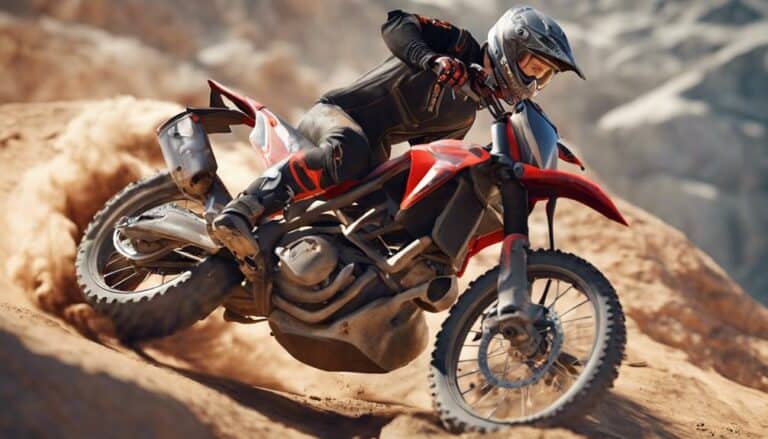As you navigate the twists and turns of off-road trails, approaching a corner on your motorcycle is akin to unraveling a puzzle where each piece must fit seamlessly for a successful outcome.
The key factors to think about go beyond just speed and include a delicate balance of technique, terrain assessment, and strategic decision-making.
By mastering these elements, you not only enhance your riding skills but also make sure a safe and exhilarating journey through the unpredictable landscapes that await you.
Key Takeaways
- Assess terrain for challenges like loose gravel or mud to adjust speed and weight distribution.
- Utilize countersteering technique for stability and quick maneuvering in off-road corners.
- Navigate S-Bends with precision by choosing optimal paths and maintaining proper body position.
- Approach decreasing-radius turns with confidence, leaning smoothly and adjusting for tightening curvature.
Riding Conditions Assessment
Assess the terrain meticulously for loose gravel, sand, rocks, or mud before tackling the corner on your off-road motorcycle. The terrain assessment is important as it dictates how you approach the corner.
Adjust your weight on the bike to maintain balance and control. Your cornering technique should adapt to the terrain, ensuring a smooth and safe maneuver.
Consider your speed relative to the terrain conditions; slowing down on loose surfaces can prevent loss of traction. Your cornering skills will be put to the test, so anticipate the challenges the terrain presents.
Importance of Countersteering Technique
Mastering the countersteering technique is paramount for achieving precise control and precision when tackling corners on your off-road motorcycle, especially in challenging terrain. Countersteering on an off-road motorcycle involves applying pressure to the handlebars in the opposite direction of the intended turn. This action initiates the lean of the bike, allowing you to traverse corners smoothly and efficiently.
In off-road riding, where conditions can be unpredictable, countersteering plays a vital role in maintaining stability and control while maneuvering through tight corners. By understanding and practicing this technique, you can enhance your cornering skills and confidently handle various terrains. The ability to countersteer effectively gives you the advantage of quick and responsive maneuvering, enabling you to adjust your trajectory when negotiating corners on your off-road motorcycle.
Executing S-Bends With Precision
To excel in executing S-Bends with precision on your off-road motorcycle, understanding the unique challenges posed by these successive turns in opposite directions is essential. When approaching S-Bends, focus on the following key factors:
- Line Selection: Choose the best path through the S-Bend to maintain momentum and control.
- S.E.E. Method: Utilize the Search, Evaluate, Execute approach to assess and tackle S-Bends effectively.
- Body Position: Maintain a proper body position to shift weight and handle the changing directions smoothly.
- Weight Distribution: Distribute your weight effectively to enhance traction and stability while cornering.
- Cornering Techniques: Practice and master different cornering techniques to flow seamlessly through the S-Bends with precision.
Navigating Decreasing-Radius Turns
Handling decreasing-radius turns demands precise control and strategic adjustments to negotiate the tightening curvature safely. As you approach these challenging turns, make sure you maintain cornering confidence by entering at an appropriate speed that allows for adjustments. Lean the bike into the turn while smoothly shifting your weight to the inside, optimizing traction and stability. Employ the delayed apex technique, focusing on a later turn-in point to enhance visibility and control throughout the corner. By mastering these techniques, you can efficiently navigate decreasing-radius turns with finesse and skill.
| Key Factors to Consider | |||
|---|---|---|---|
| Cornering Confidence | Appropriate Speed | Lean the Bike | Shift Your Weight |
| Utilize Experience | Strategic Adjustments | Delayed Apex Technique | Precise Control |
Mastering Delayed Apex Turns
When approaching delayed apex turns, a strategic entry point is essential for maximizing visibility and control.
To master these turns effectively, consider the following:
- Approach the turn wide and late: By delaying the apex, you can assess the corner better before committing to the maneuver.
- Maintain a seated position: Keeping your body weight centered and low will help you navigate the turn with stability and control.
- Roll on the throttle smoothly: Gradually applying throttle as you lean into the turn will help maintain traction and propel you through the corner.
- Lean into the turn: Shift your body weight towards the inside of the turn to counterbalance the bike's lean angle and improve stability.
- Adjust your line for a safer exit: Delaying the apex allows you to adapt your trajectory and speed, setting you up for a smoother and more efficient exit.
Conclusion
As you approach a corner on your off-road motorcycle, remember to assess the road conditions, utilize countersteering techniques, and execute precise S-bends and decreasing-radius turns.
By mastering delayed apex turns, you can navigate corners with confidence and skill. Stay focused, adjust your speed accordingly, and always prioritize safety.
With practice and attention to detail, you can conquer any corner with finesse and control. Ride on, and enjoy the thrill of off-road motorcycle adventures.

